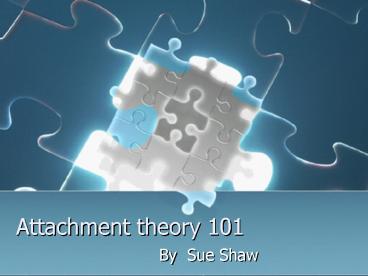Attachment theory 101 - PowerPoint PPT Presentation
1 / 17
Title: Attachment theory 101
1
Attachment theory 101
- By Sue Shaw
2
The theorists
- John Bowlby originally developed the concept of
attachment. He was a British developmentalist
who was inspired by both psychoanalytic theory
and the study of patterns of animal behavior. He
was particularly interested in the observations
of the interactions of monkeys. - Mary Ainsworth, a young American graduate student
devoted her career to defining and measuring
attachment.
3
What is attachment?
- Mary Ainsworth stated that attachment may be
defined as an affectional tie that one person or
animal forms between himself and another specific
onea tie that binds them together in space and
endures over time.(1973) - Or simply
- Attachment is a strong, affectional tie that
individuals feel toward special people in their
lives.
4
It has been said
- Parents who fall in love with their children,
have children who fall in love with their parents
5
Attachment involves..
- A complex, ongoing process.
- A two-way experience
- It requires both a closeness and a responsiveness
6
Attachment happens in every culture..
7
Attachment theory is
- the belief that these strong affectionate ties
that an individual feel toward special people in
their lives influence mental, social, and
emotional development and are vital to healthy
development in each of these areas.
8
Brain research and attachment
- How a brain develops hinges on a complex
interplay between the genes youre born with and
the experiences you have. - Early experiences have a decisive impact of the
how the brain develops. - The connections used regularly become reinforced
and protected and become part of the brains
permanent wiring.
9
Early attachment factors include
- Overall sensitivity to the infants basic needs
food, stimulation, soothing - Responsiveness to specific signals, such as
vocalizations and facial expressions - Play in which the caregiver actively encourages
ongoing development
10
Attachment and the Social Context
- A securely attached toddler plays happily when
the her caregiver is presentthey feel secure and
safe - When people are attached they try to be near each
other and interact with each otherthey display
proximity seeking behaviorsand contact
maintaining behaviors
11
Attachment and emotional health
- Every theory recognizes the importance of the
early relationship between the infant and
caregiver. - The two must form a bond (attachment) that allows
the infant to rely on the caregiver for security
and support - This bond allows the infant courage to explore
their environment - The bond allows for a feeling of
- safeness
12
Attachment ensures survival
- Bowlby said that attachment is a means of
ensuring survival of the child and also of the
species (1969) - It creates the caring (the feelings) that
motivates the action of giving care. - The first attachment(s) provide the foundation
for all later relationships
13
Children with special needs
- For infants and toddler with a special need the
nurturing support of a knowledgeable care giver
can make all the difference in their ability to
grow and develop. - The more we know about attachment and how to
support it's development the more we can respond
to the needs of the child whether expressed or not
14
Warning signs of insecure attachment
- A infant in your care that does not thrive in
the same way the other babies do. She may not be
gaining weight or reaching milestones - The baby is unresponsive to everybody
- The infant responding the same to
everyonecaregiver and stranger - The child may become passive and non-complaining
- The child may seem disorganized in his thought
patterns
15
What could prevent attachment from forming?
- Parents that may be unhappy about the pregnancy
or unhappy with each other - A parent who is addicted to drugs or alcohol
- Parents who miss out on the initial bonding
period because of illness, accidents, adoptions - Temperament that is a mismatch between the parent
and the child
16
Patterns of Attachment
- Secure (type B) Explores freely when the
caregiver is present - Insecure-avoidant (type A) Explores freely,
uninterested in the caregivers presence or
departure - Insecure-resistant/ambivalent (type C) Resists
active exploration, preoccupied with caregiver - Disorganized (type D) Neither plays freely nor
responds to the caregiver in one coherent mode.
May cry, hit, show fear, move slow
17
Summary
- Secure attachments influence the way a child
makes sense of his world - The first two years are the foundation for a long
developmental history - Trust and attachment are lifelong issues
- View the Bonding segment of First 5
Californias The First Years Last Forever video































